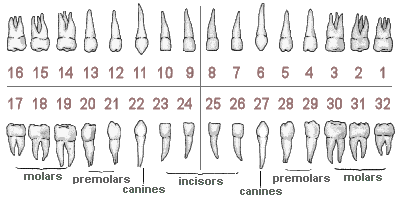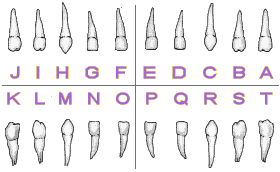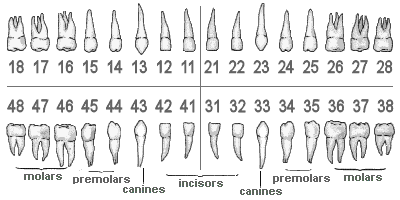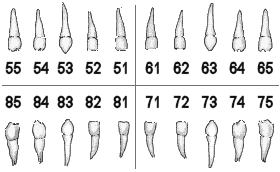by Costas Bougalis April 16, 1998 (Last update May 12, 2019)
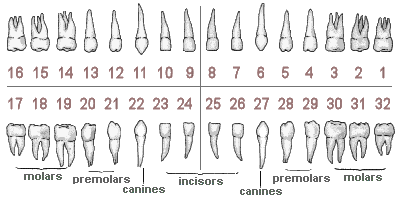
Teeth Names & Numbers
Dentists refer to a specific tooth using a number or coding more usually than using teeth names. There are several teeth numbering systems: the Universal Numbering System (used in US), FDI World Dental Federation notation, and the Palmer Notation Method. However, for patients it is easier to identify and remember the different teeth by using more descriptive teeth names instead of numbers or other coding.
Universal tooth numbering system
The Universal Numbering System is a simplified method of identifying teeth that is approved and adopted by the American Dental Association.
AdultsIn the universal tooth numbering system, tooth number 1 is the patient's upper right third molar, on the right side of the mouth in the upper (maxillary) jaw. Numbering of teeth continues along the upper teeth toward the front and across to the last molar tooth back on the top left side (number 16). The tooth numbering continues by assigning teeth numbers descending to the lower left third molar (number 17) and follows the lower (mandibular) jaw up to the tooth farthest back on the bottom right side of the mouth (number 32). All teeth that should be there are numbered, including those teeth that have been removed for any reason or have not erupted yet (e.g. wisdom teeth).
ChildrenIn the original system, children's 20 primary teeth are numbered in the same order (from 1 to 20), except that a small letter "d" follows each number to indicate deciduous (primary) teeth.
However, most dentists today use a modified version of the Universal Numbering System for children, with letters instead of teeth numbers. The primary teeth are designated by upper case letters A through T, with A being the patient's upper right second primary molar and T being the lower right second primary molar.
|
||||||||||||||||||
FDI World Dental Federation Two-Digit Notation (international)
The second system, developed by the Fédération Dentaire Internationale (FDI), World Dental Federation notation is also known as ISO-3950 notation.
The human teeth are symmetrically arranged in the mouth. Each quadrant of the mouth has 8 different teeth that are mirrored horizontally and vertically to the other quadrants. In the FDI notation each one of these 8 teeth is assigned a number from 1 to 8, starting from the center front tooth (central incisor) and moving backwards up to the third molar (number 8). Each quadrant is also assigned a number, from 1 to 4 for the adult (permanent) teeth or 5 to 8 for the baby (primary or deciduous) teeth.
| Quadrant codes | Tooth codes | ||
| Adult teeth | Baby teeth | ||
| 1 - upper right | 5 - upper right | 1 - central incisor | 5 - 2nd premolars |
| 2 - upper left | 6 - upper left | 2 - lateral incisors | 6 - 1st molars |
| 3 - lower left | 7 - lower left | 3 - canines | 7 - 2nd molars |
| 4 - lower right | 8 - lower right | 4 - 1st premolars | 8 - 3rd molars |
The combination of these two numbers (Quadrant code number & Tooth code number) specifies how are teeth numbered. This tooth numbering system is called, the Two-Digit World Dental Federation Notation or FDI notation system.
|
Adults
Children
|
||||||||||||||||||
How are teeth named and numbered?
Teeth names are created by a combination of 4 different characteristics:
- The jaw where they are located: upper and lower (alternatively the terms maxillary and mandibular can be used)
- The side of the face: left and right
- The type of tooth: incisor, canine, premolar, and molar
- A secondary name for the teeth types that appear more than once in each quadrant of the mouth e.g. central and lateral for incisors, first and second for premolars, first, second, and third for molars.
Based on these characteristics, the teeth names for the permanent dentition are the following (starting from the upper right back tooth and moving anti-clockwise):
Next to its tooth you can see the tooth number based on:
a) the Universal Numbering System (UNS) used in the United States and b) the FDI notation (FDI)
Permanent Teeth Names & Numbers
| Permanent Teeth | UNS | FDI | FDI | UNS | ||
| Upper left third molar | 16 | 28 | 18 | 1 | Upper right third molar | |
| Upper left second molar | 15 | 27 | 17 | 2 | Upper right second molar | |
| Upper left first molar | 14 | 26 | 16 | 3 | Upper right first molar | |
| Upper left second premolar | 13 | 25 | 15 | 4 | Upper right second premolar | |
| Upper left first premolar | 12 | 24 | 14 | 5 | Upper right first premolar | |
| Upper left canine | 11 | 23 | 13 | 6 | Upper right canine | |
| Upper left lateral incisor | 10 | 22 | 12 | 7 | Upper right lateral incisor | |
| Upper left central incisor | 9 | 21 | 11 | 8 | Upper right central incisor | |
| Lower left central incisor | 24 | 31 | 41 | 25 | Lower right central incisor | |
| Lower left lateral incisor | 23 | 32 | 42 | 26 | Lower right lateral incisor | |
| Lower left canine | 22 | 33 | 43 | 27 | Lower right canine | |
| Lower left first premolar | 21 | 34 | 44 | 28 | Lower right first premolar | |
| Lower left second premolar | 20 | 35 | 45 | 29 | Lower right second premolar | |
| Lower left first molar | 19 | 36 | 46 | 30 | Lower right first molar | |
| Lower left second molar | 18 | 37 | 47 | 31 | Lower right second molar | |
| Lower left third molar | 17 | 38 | 48 | 32 | Lower right third molar |
Left and Right on the teeth chart correspond to the patient's left and right respectively (patient's view).
Primary (Baby or Deciduous) Teeth Names & Numbers
For primary teeth, most dentists in United States use a modified version of the Universal Numbering System, with each primary tooth assigned a letter (from A to T) instead of a number.
| Primary Teeth | UNS | FDI | FDI | UNS | ||
| Upper left second molar | J | 65 | 55 | A | Upper right second molar | |
| Upper left first molar | I | 64 | 54 | B | Upper right first molar | |
| Upper left canine | H | 63 | 53 | C | Upper right canine | |
| Upper left lateral incisor | G | 62 | 52 | D | Upper right lateral incisor | |
| Upper left central incisor | F | 61 | 51 | E | Upper right central incisor | |
| Lower left central incisor | O | 71 | 81 | P | Lower right central incisor | |
| Lower left lateral incisor | N | 72 | 82 | Q | Lower right lateral incisor | |
| Lower left canine | M | 73 | 83 | R | Lower right canine | |
| Lower left first molar | L | 74 | 84 | S | Lower right first molar | |
| Lower left second molar | K | 75 | 85 | T | Lower right second molar |
Left and Right on the teeth chart correspond to the patient's left and right respectively (patient's view).
Other teeth names
Other common teeth names:
- Cuspids: Another name for canines
- Bicuspids: Another name for premolars
- 6 year molar: Another name for first permanent molar
- 12 year molar: Another name for second permanent molar
- Wisdom Teeth: A popular name for the third molars
- Anterior Teeth: The teeth in the front of the mouth including central incisors, lateral incisors, and canines.
- Posterior Teeth: The teeth in the back of the mouth including premolars and molars.
- Mandibular Teeth: The teeth on the lower jaw
- Maxillary Teeth: The teeth on the upper jaw
Wheeler’s dental anatomy, physiology, and occlusion. Ash M M, Stanley JN. Saunders Elsevier 8th ed 2005.
Dental Anthropology: Fundamentals, Limits and Prospects. Kurt W. Alt, Friedrich W. Rösing, Maria Teschler-Nicola. Springer. 1st edition Jan 1, 1998.
Tooth Numbering Systems. Oral Health Topics A–Z. American Dental Association (Archived) Nov 2, 2006.
FDI Two-Digit Notation. FDI World Dental Federation (Archived) April 1, 2007.
Tooth numbering systems: a final choice. Schwartz S, Stege, D. Ann Dent 1977; 36: 99-106
Fédération Dentaire Internationale two-digit system of designating teeth. Keiser-Nielsen S. Int Dent J 1971; 21:104-106
Palmer’s dental notation. Palmer C. Dent Cosmos 1891; 33:194-198

